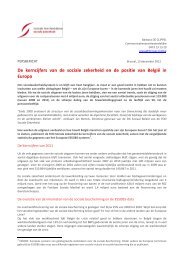Sustainability and adequacy of pensions in EU countries. A cross ...
Sustainability and adequacy of pensions in EU countries. A cross ...
Sustainability and adequacy of pensions in EU countries. A cross ...
Create successful ePaper yourself
Turn your PDF publications into a flip-book with our unique Google optimized e-Paper software.
Belgian Presidency <strong>of</strong> the<br />
Council <strong>of</strong> the European Union<br />
<strong>Susta<strong>in</strong>ability</strong> <strong>and</strong> <strong>adequacy</strong> <strong>of</strong> <strong>pensions</strong> <strong>in</strong> <strong>EU</strong> <strong>countries</strong><br />
A <strong>cross</strong>-national perspective<br />
The paper is based upon the presentation <strong>of</strong> the author to the conference under the Belgian<br />
Presidency <strong>of</strong> the Council <strong>of</strong> the European Union, "Assur<strong>in</strong>g Adequate Pensions <strong>and</strong> Social<br />
Benefits for All European Citizens", held at Liège, 6-8 September 2010.<br />
By Asghar Zaidi<br />
European Centre for Social Welfare Policy <strong>and</strong> Research, Vienna<br />
September 2010<br />
Author is grateful for the Belgian Federal Public Service Social Security, particularly Koen<br />
Vlem<strong>in</strong>ckx, for the support <strong>in</strong> carry<strong>in</strong>g out this work. Many thanks to Katr<strong>in</strong> Gasior, who<br />
prepared the graphs <strong>in</strong>cluded <strong>in</strong> the paper. The views expressed <strong>in</strong> the paper are authors’ own<br />
<strong>and</strong> they are not necessarily shared by the Belgian Government, or by the European<br />
Commission.
Table <strong>of</strong> Contents<br />
PREFACE .............................................................................................................................. 2<br />
1. SETTING THE CONTEXT: THE SUSTAINABILITY CONCERNS .................................................. 3<br />
A. THE POPULATION AGEING CHALLENGES .......................................................................................... 3<br />
B. THE JOBS CRISIS.......................................................................................................................... 4<br />
C. THE FISCAL CRISIS ....................................................................................................................... 5<br />
D. FINANCIAL SUSTAINABILITY CHALLENGES: AGEING AS A CONTRIBUTORY FACTOR.................................... 6<br />
2. PENSION REFORMS AND THEIR AGGREGATE IMPACT: EVOLUTION OF THE BENEFIT RATIO 9<br />
3. IMPACT OF REFORMS ON THE STRUCTURE OF FUTURE PENSION SYSTEMS ...................... 10<br />
4. IMPACT OF REFORMS: CHANGES IN THE AVERAGE FIRST PENSION .................................. 12<br />
5. POLICY CHALLENGES GOING FORWARD! ......................................................................... 14<br />
REFERENCES ...................................................................................................................... 16<br />
ANNEX A ........................................................................................................................... 17<br />
1
<strong>Susta<strong>in</strong>ability</strong> <strong>and</strong> <strong>adequacy</strong> <strong>of</strong> <strong>pensions</strong> <strong>in</strong> <strong>EU</strong> <strong>countries</strong><br />
A <strong>cross</strong>-national perspective<br />
Preface<br />
The f<strong>in</strong>ancial susta<strong>in</strong>ability challenges that <strong>EU</strong> <strong>countries</strong> face are well documented, but the<br />
impact <strong>of</strong> policy reforms now on the structure <strong>of</strong> future pension systems <strong>and</strong> on <strong>in</strong>comes <strong>of</strong><br />
future retirees is less clearly del<strong>in</strong>eated. Similarly, the need for susta<strong>in</strong>ed policy remedies to<br />
the current economic <strong>and</strong> fiscal crises is widely recognised, yet the effects <strong>of</strong> actions taken<br />
now on the nature <strong>of</strong> future social challenges aris<strong>in</strong>g are masked.<br />
This paper addresses these issues, <strong>and</strong> is based upon the author’s presentation to the<br />
conference under the Belgian Presidency <strong>of</strong> the Council <strong>of</strong> the European Union, "Assur<strong>in</strong>g<br />
Adequate Pensions <strong>and</strong> Social Benefits for All European Citizens", held at Liège, 6-8 September<br />
2010. The analyses emphasize the need for policy-makers to be aware <strong>of</strong> the impacts <strong>of</strong><br />
decisions on susta<strong>in</strong>ability issues <strong>and</strong> on fiscal consolidation upon pension systems’ structures<br />
<strong>and</strong> on pension <strong>in</strong>come <strong>adequacy</strong> for future pensioners.<br />
This paper builds on from an earlier policy brief (Zaidi 2010a), which stratified <strong>EU</strong> <strong>countries</strong><br />
accord<strong>in</strong>g to the poverty risks <strong>of</strong> its older populations (aged 65 or more) <strong>in</strong> 2008, <strong>and</strong> reported<br />
on the current <strong>adequacy</strong> <strong>of</strong> retirement <strong>in</strong>comes. The outcomes reflect both the <strong>in</strong>fluence <strong>of</strong><br />
past pension policies <strong>and</strong> also the labour market <strong>and</strong> demographic experiences <strong>in</strong> work<strong>in</strong>g life<br />
<strong>of</strong> current retirees. Extrapolat<strong>in</strong>g this picture forward to depict how current generations <strong>of</strong><br />
workers will fare <strong>in</strong> their <strong>in</strong>comes as <strong>and</strong> when they retire is the major part <strong>of</strong> this paper. In<br />
do<strong>in</strong>g so, it uses projections <strong>and</strong> simulations on <strong>in</strong>come entitlements <strong>of</strong> future retirees <strong>in</strong> <strong>EU</strong><br />
<strong>countries</strong>, as provided by the <strong>EU</strong>’s Economic Policy Committee <strong>and</strong> the Social Policy Committee<br />
<strong>and</strong> the OECD.<br />
The context is that although the shocks to global systems caused by the f<strong>in</strong>ancial nearmeltdowns<br />
<strong>in</strong> 2008 <strong>and</strong> 2009 are beg<strong>in</strong>n<strong>in</strong>g to recede, its effects will rema<strong>in</strong> with us for<br />
decades to come. National economies are now saddled with structural debts, partly as a result<br />
<strong>of</strong> choices made over the boom years <strong>and</strong> partly <strong>in</strong> pursu<strong>in</strong>g expansionary policies dur<strong>in</strong>g the<br />
recession. Although signs <strong>of</strong> economic recovery are visible, the effect <strong>of</strong> unemployment as<br />
well as cutbacks required for budgetary consolidations on the vulnerable groups <strong>of</strong> the society,<br />
particularly pensioners, could run deep. The shape <strong>and</strong> design <strong>of</strong> future pension policy, <strong>and</strong><br />
how that policy will be <strong>in</strong>fluenced by choices made now <strong>in</strong> response to the current fiscal crisis,<br />
future population age<strong>in</strong>g challenges, <strong>and</strong> the welfare <strong>of</strong> future pensioners, is discussed here.<br />
Such questions as were asked by Gaugu<strong>in</strong> at the turn <strong>of</strong> 19 th century – D'où Venons Nous / Que<br />
Sommes Nous / Où Allons Nous (Where Do We Come From? What Are We? Where Are We<br />
Go<strong>in</strong>g?) – at a critical moment <strong>in</strong> his life, are also particularly pert<strong>in</strong>ent for <strong>EU</strong>’s pension policymakers<br />
<strong>in</strong> the current times.<br />
2
This paper is organised <strong>in</strong> five sections. Section 1 sets the context by highlight<strong>in</strong>g susta<strong>in</strong>ability<br />
challenges aris<strong>in</strong>g from population age<strong>in</strong>g, <strong>and</strong> the f<strong>in</strong>ancial, fiscal, <strong>and</strong> economic crises.<br />
Section 2 analyses the aggregate impact <strong>of</strong> pension reforms, us<strong>in</strong>g the <strong>in</strong>dicator ‘Benefit Ratio’,<br />
as calculated by the Work<strong>in</strong>g Group on Age<strong>in</strong>g <strong>of</strong> the <strong>EU</strong>’s Economic Policy Committee. Section<br />
3 extends the discussion on pension <strong>in</strong>come <strong>adequacy</strong> by exam<strong>in</strong><strong>in</strong>g how pension reforms<br />
have reshaped the structure <strong>of</strong> pension systems a<strong>cross</strong> <strong>EU</strong> <strong>countries</strong>. These impact-<strong>of</strong>-pensionreforms<br />
results are derived from the simulations <strong>of</strong> pension <strong>in</strong>come entitlements for future<br />
retirees, undertaken by OECD <strong>in</strong> 2009. The next section (Section 4) presents micro evidence<br />
on changes <strong>in</strong> the entitlement <strong>of</strong> public pension <strong>in</strong>come dur<strong>in</strong>g the period 2006-2046. The<br />
<strong>in</strong>dicator <strong>in</strong> use is the net ‘Theoretical Replacement Rate’, as provided by the Indicators Sub-<br />
Group <strong>of</strong> the <strong>EU</strong>’s Social Protection Committee. Like OECD calculations, it is calculated for<br />
stylised workers, approximat<strong>in</strong>g impact <strong>of</strong> pension reforms for the <strong>in</strong>come entitlement <strong>of</strong><br />
future retirees. Section 5’s conclud<strong>in</strong>g summary discusses policy challenges that <strong>EU</strong> <strong>countries</strong><br />
face go<strong>in</strong>g forward, with a dual focus on pension policy impacts as well as the fiscal <strong>and</strong> labour<br />
market policy.<br />
1. Sett<strong>in</strong>g the context: the susta<strong>in</strong>ability concerns<br />
a. The population age<strong>in</strong>g challenges<br />
An essential start<strong>in</strong>g po<strong>in</strong>t is to assess the vary<strong>in</strong>g extent <strong>of</strong> population age<strong>in</strong>g faced by <strong>EU</strong><br />
<strong>countries</strong>. The <strong>EU</strong> <strong>of</strong> today had already, by 1950, the highest old-age dependency ratio <strong>in</strong> the<br />
world, <strong>and</strong> dur<strong>in</strong>g the period 2000 to 2050 the largest <strong>in</strong>creases are projected to take place <strong>in</strong><br />
Japan (by close to 50%-po<strong>in</strong>ts), Ch<strong>in</strong>a <strong>and</strong> the <strong>EU</strong>27 (by almost 30%-po<strong>in</strong>ts). 1<br />
Figure 1 shows this ratio <strong>of</strong> over 65s to work<strong>in</strong>g age (15-64) population <strong>in</strong> the <strong>EU</strong> 27 <strong>countries</strong>,<br />
with the trend between 2008 (actual, blue) <strong>and</strong> 2060 (projected, green). The average ratio<br />
predicted for the <strong>EU</strong>27 is 54% <strong>in</strong> 2060, <strong>and</strong> this is a stagger<strong>in</strong>g <strong>in</strong>crease from 25% <strong>in</strong> 2008. This<br />
implies that, on average, the <strong>EU</strong> would move from hav<strong>in</strong>g four work<strong>in</strong>g-age people for every<br />
person aged 65+ to a ratio <strong>of</strong> two to one. This steep rise <strong>in</strong> the old-age demographic<br />
dependency ratio will exert not just significant additional dem<strong>and</strong>s on future public f<strong>in</strong>ances <strong>in</strong><br />
the form <strong>of</strong> ris<strong>in</strong>g expenditures on <strong>pensions</strong>, health <strong>and</strong> long-term care but also they will have<br />
an adverse impact on growth potential at national levels.<br />
Note also the list <strong>of</strong> <strong>countries</strong> (boxed) on the left-h<strong>and</strong> side <strong>of</strong> the graph – a bloc <strong>of</strong> <strong>countries</strong><br />
from the former communist states <strong>of</strong> Central <strong>and</strong> Eastern Europe (CEE). The unique<br />
conjunction <strong>of</strong> ris<strong>in</strong>g longevity <strong>and</strong> low fertility as well as emigration makes population age<strong>in</strong>g<br />
a truly challeng<strong>in</strong>g phenomenon <strong>in</strong> CEE <strong>countries</strong>. This situation will greatly impact on their<br />
ability to address the challenges <strong>of</strong> pension <strong>in</strong>come <strong>adequacy</strong> <strong>and</strong> susta<strong>in</strong>ability <strong>in</strong> the future,<br />
<strong>and</strong> they will require support from the rest <strong>of</strong> the <strong>EU</strong> <strong>in</strong> meet<strong>in</strong>g these challenges.<br />
1 These conclusions are drawn from the estimates based on the UN World Population Prospects: The<br />
2008 Revision, as referred to <strong>in</strong> European Commission (2009a), p. 48.<br />
3
Figure 1: Population Age<strong>in</strong>g <strong>in</strong> <strong>EU</strong> <strong>countries</strong>, 2008-2060, as given by the old-age dependency<br />
ratio (number <strong>of</strong> 65+/number <strong>of</strong> 15-64)<br />
b. The jobs crisis<br />
By the middle <strong>of</strong> 2010, most <strong>EU</strong> <strong>countries</strong> have recovered to positions <strong>of</strong> positive growth,<br />
albeit tentative <strong>in</strong> some <strong>countries</strong>. This return to growth has resulted <strong>in</strong> a steadier <strong>in</strong>flux <strong>of</strong><br />
government revenues, <strong>and</strong> the higher growth po<strong>in</strong>ts to better prospects for a fiscally<br />
susta<strong>in</strong>able development path for <strong>EU</strong> <strong>countries</strong>. However, this recovery <strong>in</strong> growth has not<br />
been accompanied by improvements <strong>in</strong> employment.<br />
Figure 2 gives an account <strong>of</strong> unemployment rate a<strong>cross</strong> <strong>EU</strong> <strong>countries</strong>, dur<strong>in</strong>g 2006, 2009 <strong>and</strong><br />
2010. On average, the unemployment rate rose from 8% to 9% dur<strong>in</strong>g 2006-2009, <strong>and</strong> further<br />
to 10% dur<strong>in</strong>g 2010. There have been wide variations a<strong>cross</strong> <strong>countries</strong>: the unemployment<br />
rate <strong>in</strong> Latvia <strong>and</strong> Spa<strong>in</strong> has doubled <strong>and</strong> reached close to 20%. The rate <strong>in</strong> the Netherl<strong>and</strong>s<br />
<strong>and</strong> Austria, by contrast, were closer to 5% level dur<strong>in</strong>g the whole <strong>of</strong> this period.<br />
Once aga<strong>in</strong>, the CEE <strong>countries</strong>, with five out <strong>of</strong> the seven states with the highest<br />
unemployment rate dur<strong>in</strong>g 2010, st<strong>and</strong> out as a group<strong>in</strong>g. Workers <strong>in</strong> CEE <strong>countries</strong> face the<br />
much greater likelihood <strong>of</strong> a disrupted work<strong>in</strong>g career, which will adversely affect their<br />
accumulation <strong>of</strong> pension rights. Thus, the future challenges <strong>in</strong> susta<strong>in</strong><strong>in</strong>g economic growth <strong>and</strong><br />
competiveness <strong>in</strong> CEE <strong>countries</strong> can be expected to be disproportionate <strong>in</strong> comparison to<br />
other Western European <strong>EU</strong> <strong>countries</strong>. The worker position would be compounded by the<br />
young market economy status that CEE <strong>countries</strong> have, as we shall refer to later.<br />
4
Figure 2: Unemployment rate <strong>in</strong> percent, 2006, 2009 <strong>and</strong> 2010<br />
c. The fiscal crisis<br />
Dur<strong>in</strong>g 2009, the key challenge a<strong>cross</strong> the World has undoubtedly been to counteract the<br />
recession. Consequently unprecedented fiscal <strong>and</strong> monetary policy measures were put <strong>in</strong><br />
place, so as to stimulate economies <strong>and</strong> stabilize f<strong>in</strong>ancial markets. Heavy public spend<strong>in</strong>g<br />
either <strong>in</strong> the form <strong>of</strong> large fiscal stimulus packages or <strong>in</strong> automatic stabilizers put enormous<br />
additional stra<strong>in</strong> on public f<strong>in</strong>ances dur<strong>in</strong>g 2009, <strong>and</strong> almost all European governments faced a<br />
significant deterioration <strong>in</strong> their public f<strong>in</strong>ances. Government deficits among <strong>EU</strong> states rose<br />
substantially, from an average <strong>of</strong> -1.4% <strong>of</strong> GDP <strong>in</strong> 2006 to -6.8% <strong>in</strong> 2009 (see Figure 3 below),<br />
lead<strong>in</strong>g to an accumulation <strong>of</strong> large government debts. This situation raises fresh concerns<br />
regard<strong>in</strong>g the susta<strong>in</strong>ability <strong>of</strong> public f<strong>in</strong>ances <strong>in</strong> many <strong>EU</strong> states, which rema<strong>in</strong>s a live <strong>and</strong><br />
ongo<strong>in</strong>g challenge <strong>in</strong> many <strong>EU</strong> <strong>countries</strong>.<br />
As discussed <strong>in</strong> detail <strong>in</strong> Zaidi <strong>and</strong> Rejniak (2010), CEE <strong>countries</strong> faced additional susta<strong>in</strong>ability<br />
challenges, attributed largely to their young market economy status. Hav<strong>in</strong>g made the<br />
transition to the market economy dur<strong>in</strong>g the 1990s, these <strong>countries</strong> have not had the benefit<br />
<strong>of</strong> prolonged periods <strong>of</strong> economic growth <strong>and</strong> also have gone through the political transition<br />
towards democratic <strong>in</strong>stitutions relatively recently. While <strong>EU</strong> accession <strong>and</strong> <strong>in</strong>creased<br />
opportunities <strong>of</strong> trade cooperation <strong>and</strong> foreign direct <strong>in</strong>vestment strengthened their transition<br />
to the market economy, it is nonetheless somewhat ironic that the same greater l<strong>in</strong>ks with the<br />
global economy that followed <strong>EU</strong> membership were a big factor <strong>in</strong> mak<strong>in</strong>g these <strong>countries</strong><br />
particularly vulnerable to economic shocks.<br />
5
Figure 3: Government deficit (-) / surplus (+) <strong>in</strong> <strong>EU</strong> <strong>countries</strong>, <strong>in</strong> terms <strong>of</strong> percentage<br />
<strong>of</strong> GDP, 2006 <strong>and</strong> 2009<br />
Note also that the CEE <strong>countries</strong> have sided with the ‘austerity now’ arguments <strong>and</strong> have<br />
therefore already embarked on various budgetary consolidation measures. Such a choice is<br />
partly driven by the IMF <strong>and</strong> the <strong>EU</strong> conditionality, so as to raise market confidence on public<br />
governance <strong>in</strong> these <strong>countries</strong>, <strong>and</strong> partly due to CEE <strong>countries</strong>’ ambitions to deal with their<br />
own structural problems <strong>and</strong> jo<strong>in</strong> the Eurozone <strong>countries</strong> (ibid, pp.8).<br />
d. F<strong>in</strong>ancial susta<strong>in</strong>ability challenges: Age<strong>in</strong>g as a contributory factor<br />
A specific question is therefore how the comb<strong>in</strong>ation <strong>of</strong> age<strong>in</strong>g populations <strong>and</strong> fiscal crisis will<br />
affect <strong>EU</strong> <strong>countries</strong>’ f<strong>in</strong>ancial susta<strong>in</strong>ability <strong>in</strong> the future. The ga<strong>in</strong>s <strong>in</strong> human longevity have<br />
<strong>in</strong>deed been a positive trend, particularly <strong>in</strong> CEE <strong>countries</strong> where life expectancy has been<br />
lower than that <strong>in</strong> other <strong>EU</strong> <strong>countries</strong>. But, ris<strong>in</strong>g longevity comb<strong>in</strong>ed with fall<strong>in</strong>g fertility has<br />
led to shr<strong>in</strong>k<strong>in</strong>g work<strong>in</strong>g age populations <strong>in</strong> many <strong>EU</strong> <strong>countries</strong>. An additional challenge for the<br />
CEE <strong>countries</strong> is emigration <strong>of</strong> a large number <strong>of</strong> workers to other <strong>EU</strong> <strong>countries</strong>.<br />
Another clear lesson from the public f<strong>in</strong>ance crisis is the need to further ref<strong>in</strong>e the quality,<br />
consistency <strong>and</strong> <strong>in</strong>dependence <strong>of</strong> the evidence base from which decisions are made: the more<br />
high-quality evidence is admitted to this debate as the accepted start<strong>in</strong>g po<strong>in</strong>t for discussion<br />
on what to do next, the easier it becomes to formulate policy responses <strong>and</strong> persuade the<br />
public about the need for, <strong>and</strong> the consequences <strong>of</strong> change. The <strong>EU</strong>’s Economic Policy<br />
Committee’s Work<strong>in</strong>g Group on Age<strong>in</strong>g has made important progress <strong>in</strong> this respect, by<br />
collat<strong>in</strong>g results on the <strong>in</strong>dicator <strong>of</strong> f<strong>in</strong>ancial susta<strong>in</strong>ability gap (namely: S2), which can be<br />
analysed here to highlight the vary<strong>in</strong>g extent <strong>of</strong> susta<strong>in</strong>ability challenges faced by <strong>EU</strong> <strong>countries</strong>.<br />
The analysis <strong>of</strong> the S2 <strong>in</strong>dicator presented below draws from Zaidi (2010b), with a focus on<br />
how population age<strong>in</strong>g contributes to the fiscal susta<strong>in</strong>ability gap.<br />
6
The S2 <strong>in</strong>dicator approximates the gap (as % <strong>of</strong> GDP) that must be closed <strong>of</strong>f permanently <strong>in</strong><br />
order to ensure that the government will be able to f<strong>in</strong>ance all future public budget<br />
obligations. The <strong>in</strong>dicator provides a compact measure to approximate the size <strong>of</strong> risks to<br />
public f<strong>in</strong>ance susta<strong>in</strong>ability when a long-term perspective is taken. The S2 <strong>in</strong>dicator can be<br />
deconstructed <strong>in</strong>to two components so as to also po<strong>in</strong>t to the sources <strong>of</strong> the risks <strong>and</strong><br />
appropriate policy response required.<br />
<br />
<br />
Firstly, there is the gap aris<strong>in</strong>g due to the adverse fiscal position <strong>in</strong> the base year. The<br />
component is referred to as the Initial Budgetary Position (IBP). The IBP will exert a<br />
negative pressure <strong>in</strong> many <strong>countries</strong> because <strong>of</strong> the budget deficit dur<strong>in</strong>g 2009, largely<br />
due to economic downturn experienced dur<strong>in</strong>g 2008-2009.<br />
Secondly, there are the additional costs related to population age<strong>in</strong>g <strong>and</strong> expenditures<br />
on <strong>pensions</strong>, healthcare <strong>and</strong> long-term care. This component is referred to as the Long<br />
Term Changes (LTC). Note that the LTC results presented here still rely on the<br />
employment <strong>and</strong> GDP growth assumptions <strong>of</strong> the pre-crisis period.<br />
It needs to be emphasised here that the picture that emerges <strong>in</strong> Figure 4 errs on the<br />
‘optimistic’ side, because the bulk <strong>of</strong> the raw data used <strong>in</strong> the calculation <strong>of</strong> the S2 <strong>in</strong>dicator<br />
was collected prior to the onset <strong>of</strong> the current economic crisis. Very arguably, the revised<br />
projections would, when adjusted <strong>in</strong> l<strong>in</strong>e with the current economic realities <strong>of</strong> large<br />
government deficit <strong>and</strong> debt <strong>and</strong> (un)employment, present a less comfortable picture, <strong>and</strong> a<br />
much darker prognosis.<br />
Figure 4: <strong>Susta<strong>in</strong>ability</strong> gap (S2 <strong>in</strong>dicator) a<strong>cross</strong> <strong>EU</strong> <strong>countries</strong> <strong>and</strong> the contribution <strong>of</strong><br />
the Initial Budgetary Position (IBP), <strong>and</strong> the Long Term Changes (LTC), 2009<br />
7
Results presented <strong>in</strong> Figure 4 show that, at the <strong>EU</strong>27 level, the total S2 gap is 6.5% <strong>of</strong> the GDP.<br />
On average, the contribution <strong>of</strong> two components is almost the same: 3.2% for the IBP <strong>and</strong><br />
3.3% for the LTC. Wide variations a<strong>cross</strong> <strong>EU</strong> <strong>countries</strong> can also be observed, <strong>and</strong> <strong>countries</strong> are<br />
divided <strong>in</strong>to categories <strong>of</strong> high, medium <strong>and</strong> low risk. As many as 13 <strong>EU</strong> <strong>countries</strong> are be<strong>in</strong>g<br />
considered high risk <strong>countries</strong>. Among them, Irel<strong>and</strong>, Greece, the UK, Slovenia <strong>and</strong> Spa<strong>in</strong> have<br />
a susta<strong>in</strong>ability gap <strong>in</strong> excess <strong>of</strong> 10% <strong>of</strong> GDP. Latvia, Romania <strong>and</strong> Cyprus also do not fare well,<br />
at just below 10%.<br />
Countries also differ remarkably <strong>in</strong> terms <strong>of</strong> sources <strong>of</strong> risks, i.e. the contribution <strong>of</strong> the IBP <strong>and</strong><br />
the LTC. With<strong>in</strong> the high risk <strong>countries</strong>, the contribution <strong>of</strong> the LTC is particularly high <strong>in</strong><br />
Greece, Slovenia, Cyprus, Malta <strong>and</strong> the Netherl<strong>and</strong>s, whereas the relative contribution <strong>of</strong> the<br />
IBP is large <strong>in</strong> the UK, Latvia <strong>and</strong> Slovakia. With<strong>in</strong> the group <strong>of</strong> medium <strong>and</strong> low risk <strong>countries</strong>,<br />
Luxembourg <strong>and</strong> F<strong>in</strong>l<strong>and</strong> <strong>and</strong> also Belgium <strong>and</strong> Germany st<strong>and</strong> out for a larger contribution <strong>of</strong><br />
the LTC. As for the IBP contribution, Pol<strong>and</strong> is most notable, but also France <strong>and</strong> Portugal.<br />
How have policy-makers been respond<strong>in</strong>g to these susta<strong>in</strong>ability challenges? In many <strong>EU</strong><br />
<strong>countries</strong>, the policy responses with<strong>in</strong> the remit <strong>of</strong> labour market policies has been to enhance<br />
the employment rate <strong>of</strong> the work<strong>in</strong>g age population, especially for those with<strong>in</strong> traditional low<br />
employment groups (e.g. mothers with young children, older workers, <strong>and</strong> disabled persons<br />
with reduced work capabilities). Pension policy has sought to complement labour market<br />
policy moves, with greater <strong>in</strong>centives towards longer work<strong>in</strong>g careers, improvements <strong>in</strong> the<br />
coverage <strong>of</strong> public pension schemes for work<strong>in</strong>g age populations, the provision <strong>of</strong> suitable lowcost<br />
mechanisms to encourage private personal sav<strong>in</strong>gs <strong>and</strong>, where possible, a scal<strong>in</strong>g down <strong>of</strong><br />
pension benefit provisions to improve affordability <strong>of</strong> public pension schemes. These reforms<br />
have contributed towards improvements <strong>in</strong> the f<strong>in</strong>ancial susta<strong>in</strong>ability as well as ensur<strong>in</strong>g a<br />
better fairness between <strong>and</strong> with<strong>in</strong> generations <strong>and</strong> between men <strong>and</strong> women. Some pension<br />
reforms have also addressed the issue <strong>of</strong> pension <strong>in</strong>come <strong>adequacy</strong>, especially those that<br />
improved the coverage <strong>and</strong> the <strong>in</strong>dexation <strong>of</strong> m<strong>in</strong>imum <strong>pensions</strong>.<br />
Nonetheless, it can be argued that until recently the issue <strong>of</strong> <strong>adequacy</strong> has not been a priority<br />
<strong>in</strong> these reforms, <strong>and</strong> this paper provides a glimpse <strong>in</strong>to how the current generations <strong>of</strong><br />
workers are expected to fare with respect to their <strong>in</strong>comes when they will be retir<strong>in</strong>g. On the<br />
basis <strong>of</strong> the <strong>in</strong>formation available, three possible ways can be adopted to exam<strong>in</strong>e the<br />
evolution <strong>of</strong> pension <strong>in</strong>comes <strong>of</strong> future retirees <strong>in</strong> <strong>EU</strong> <strong>countries</strong>:<br />
1. To exam<strong>in</strong>e changes <strong>in</strong> the Benefit Ratio that measures the evolution <strong>of</strong> pension<br />
expenditures per pensioner <strong>in</strong> relation to the wage per worker. The period under<br />
consideration for these analyses is between 2007 <strong>and</strong> 2060, <strong>and</strong> these results provide<br />
the aggregate impact <strong>of</strong> the pension reforms a<strong>cross</strong> <strong>EU</strong> <strong>countries</strong>.<br />
2. To discuss the likely impact <strong>of</strong> pension reforms on the structure <strong>of</strong> future pension<br />
systems, by analys<strong>in</strong>g changes <strong>in</strong> the net replacement rate for low, average <strong>and</strong> above<br />
average wage workers. These analyses, for those workers who enter <strong>in</strong>to employment<br />
dur<strong>in</strong>g 2006 <strong>and</strong> retire <strong>in</strong> 2046, show the cumulative effect <strong>of</strong> reforms that happened<br />
s<strong>in</strong>ce early 1990s, for stylised cases <strong>of</strong> male workers who spent their full career<br />
work<strong>in</strong>g. These results are an approximation <strong>of</strong> the impact <strong>of</strong> pension reforms on the<br />
redistributive structure <strong>of</strong> pension systems.<br />
8
3. To analyse the changes expected <strong>in</strong> the average first pension as a proportion <strong>of</strong> the<br />
average wage, by us<strong>in</strong>g the case <strong>of</strong> stylised male workers on average wage throughout<br />
their work<strong>in</strong>g careers <strong>and</strong> by cover<strong>in</strong>g all m<strong>and</strong>atory <strong>and</strong> important pension schemes.<br />
This <strong>in</strong>dicator, so-called theoretical replacement rate (TRR), is calculated first for those<br />
retir<strong>in</strong>g <strong>in</strong> 2006 hav<strong>in</strong>g accumulated pension rights under the current pension policies.<br />
Then, the base TRR is compared with the prospective TRR <strong>of</strong> those retir<strong>in</strong>g <strong>in</strong> 2046<br />
accumulat<strong>in</strong>g rights under the new reformed pension system, so as to measure how<br />
pension reforms will affect future pension entitlements.<br />
These three streams <strong>of</strong> analysis provide <strong>in</strong>sights <strong>in</strong>to how pension <strong>in</strong>comes for future retirees<br />
are likely to be affected, <strong>and</strong> the next three sections <strong>of</strong> this paper address them one by one.<br />
2. Pension reforms <strong>and</strong> their aggregate impact: Evolution <strong>of</strong> the Benefit Ratio<br />
Changes <strong>in</strong> Benefit Ratios over time chart the likely development <strong>of</strong> the relative value <strong>of</strong> the<br />
average pension (total public pension spend<strong>in</strong>g divided by number <strong>of</strong> pensioners) relative to<br />
the likely evolution <strong>of</strong> the average wage (approximated by the GDP per hours worked). All<br />
other th<strong>in</strong>gs constant, a decl<strong>in</strong>e <strong>in</strong> the benefit ratio over time po<strong>in</strong>ts to a fall <strong>in</strong> the generosity<br />
<strong>of</strong> public <strong>pensions</strong>, relative to wages.<br />
The projected reduction <strong>in</strong> the Benefit Ratio can also be a sign <strong>of</strong> improv<strong>in</strong>g public f<strong>in</strong>ances.<br />
However, it can also lead to greater expenses <strong>in</strong> the form <strong>of</strong> social assistance from the<br />
government if the fall<strong>in</strong>g benefit ratio resulted <strong>in</strong> an <strong>in</strong>crease <strong>in</strong> the poverty among older<br />
people <strong>in</strong> the future. Moreover, falls <strong>in</strong> the Benefit Ratio may occur because the pension<br />
system has moved partly towards private schemes, <strong>and</strong> thus revenues <strong>and</strong> expenditures from<br />
public pension schemes will be lower <strong>in</strong> the future. Such observations should be kept <strong>in</strong> m<strong>in</strong>d<br />
when <strong>in</strong>terpret<strong>in</strong>g results for the changes <strong>in</strong> the Benefit Ratio presented below.<br />
Figure 5: Changes <strong>in</strong> the Benefit ratio % (average public <strong>pensions</strong>/average economy-wide<br />
wage) a<strong>cross</strong> <strong>EU</strong>27, for the period 2007-2046<br />
9
The results presented here are derived from the recently completed assessment <strong>of</strong> age<strong>in</strong>g<br />
related public expenditures by the European Commission. Figure 5 shows that the projected<br />
benefit ratio will be decl<strong>in</strong><strong>in</strong>g <strong>in</strong> the majority <strong>of</strong> <strong>EU</strong> <strong>countries</strong>, over the period 2007-2060<br />
(Economic Policy Committee, 2009a, pp. 111). There are also important variations a<strong>cross</strong> <strong>EU</strong><br />
states. The ma<strong>in</strong> f<strong>in</strong>d<strong>in</strong>gs with respect to the development <strong>of</strong> the Benefit Ratio can be<br />
summarised as follows:<br />
• The decl<strong>in</strong>e <strong>in</strong> the Benefit Ratio is quite strong for Pol<strong>and</strong> (-54%), Sweden (-39%),<br />
Austria (-30%), Slovakia (-27%) <strong>and</strong> France (-25%). With the exception <strong>of</strong> Slovakia, this<br />
decl<strong>in</strong>e <strong>in</strong> public pension generosity will not be <strong>of</strong>fset by other m<strong>and</strong>atory private<br />
pension schemes because the fall <strong>in</strong> the Benefit Ratio will still be more than 20%. Thus,<br />
<strong>in</strong> the absence <strong>of</strong> any counteract<strong>in</strong>g policy changes to improve <strong>adequacy</strong>, future<br />
retirees <strong>in</strong> Pol<strong>and</strong>, Sweden, Austria <strong>and</strong> France run the risk <strong>of</strong> be<strong>in</strong>g more <strong>of</strong>ten poor<br />
than is the case now.<br />
• The magnitude <strong>of</strong> decl<strong>in</strong>e <strong>in</strong> the Benefit Ratio is also quite strong for Estonia <strong>and</strong><br />
Latvia, <strong>and</strong> these <strong>countries</strong> were identified with a high at-risk-<strong>of</strong>-poverty rate for the<br />
elderly dur<strong>in</strong>g 2008. In both <strong>countries</strong>, the expected decl<strong>in</strong>e will be partially <strong>of</strong>fset by<br />
the new private <strong>pensions</strong>, although a decl<strong>in</strong>e <strong>of</strong> about 18% is still expected <strong>in</strong> Estonia.<br />
Thus, Estonia is expected to be fac<strong>in</strong>g a risk <strong>of</strong> cont<strong>in</strong>u<strong>in</strong>g to be a high poverty risk<br />
country for its older population <strong>in</strong> the future.<br />
• Portugal could be identified as the country where the poverty risk for the elderly<br />
population is expected to be higher <strong>in</strong> the future, because <strong>of</strong> its fall<strong>in</strong>g Benefit Ratio. In<br />
Italy, on the other h<strong>and</strong>, the Benefit Ratio rema<strong>in</strong>s among the highest <strong>in</strong> 2060, despite<br />
the fall observed dur<strong>in</strong>g the period 2007-2060.<br />
• Greece is <strong>in</strong> a league <strong>of</strong> its own, as it rema<strong>in</strong>s the country with by far the highest<br />
Benefit Ratio, despite a fall dur<strong>in</strong>g the period <strong>in</strong> question. However, these results do<br />
not show the probable impact <strong>of</strong> the most recent reforms <strong>in</strong> the public pension system<br />
<strong>in</strong> that country which <strong>in</strong>volves cuts <strong>in</strong> pension payments <strong>and</strong> rais<strong>in</strong>g <strong>of</strong> the retirement<br />
age for both men <strong>and</strong> women. Spa<strong>in</strong> <strong>and</strong> Cyprus are also <strong>countries</strong> that will cont<strong>in</strong>ue to<br />
have a high Benefit Ratio <strong>in</strong> the future.<br />
3. Impact <strong>of</strong> reforms on the structure <strong>of</strong> future pension systems<br />
An <strong>in</strong>formative way to analyse future changes <strong>in</strong> pension systems is to compare the Net<br />
Replacement Ratio (NRR) for stylised workers before <strong>and</strong> after pension reforms on low,<br />
average <strong>and</strong> above average wage workers. These results are provided <strong>in</strong> ‘Pensions at a Glance’<br />
(OECD, 2009; Chapter 2). Results for 12 <strong>EU</strong> <strong>countries</strong> are <strong>in</strong>cluded <strong>in</strong> Table A.1 (Annex A) <strong>and</strong><br />
they simulate the impact <strong>of</strong> reforms for those workers who entered the labour market <strong>in</strong> 2006.<br />
They compare the pension entitlement <strong>of</strong> a person who spent a full career under the reformed<br />
pension system with the pension entitlement that would have been received had the system<br />
not been changed. The results for six <strong>countries</strong> are shown <strong>in</strong> Figure 6, <strong>and</strong> they are reported <strong>in</strong><br />
terms <strong>of</strong> the NRR: that is, the value <strong>of</strong> the pension <strong>in</strong> retirement, after taxes, compared with<br />
the level <strong>of</strong> earn<strong>in</strong>gs when work<strong>in</strong>g.<br />
10
For each country, the first bar shows the position <strong>of</strong> low earners: workers earn<strong>in</strong>g 50% <strong>of</strong> the<br />
economy-wide average each year <strong>of</strong> their entire work<strong>in</strong>g life. The middle bar shows the NRR<br />
for average earners <strong>and</strong> the third bar for above average earners (workers earn<strong>in</strong>g 150% <strong>of</strong> the<br />
average). By compar<strong>in</strong>g the impact <strong>of</strong> reforms a<strong>cross</strong> these three earn<strong>in</strong>gs groups, results<br />
provide an <strong>in</strong>dication <strong>of</strong> changes <strong>in</strong> redistributive aspects <strong>of</strong> pension systems, aris<strong>in</strong>g from the<br />
cumulative reforms that have taken place dur<strong>in</strong>g the past 10-15 years.<br />
Figure 6: Changes <strong>in</strong> the Benefit ratio % (average public <strong>pensions</strong>/average economy-wide<br />
wage) a<strong>cross</strong> <strong>EU</strong>27, for the period 2007-2046<br />
Depend<strong>in</strong>g on the effect <strong>of</strong> the pension reforms on the retirement <strong>in</strong>comes <strong>of</strong> workers at<br />
different earn<strong>in</strong>gs levels, <strong>countries</strong> can be divided <strong>in</strong>to three groups: <strong>countries</strong> with reforms<br />
that protected low earners, <strong>countries</strong> with reforms that strengthened the l<strong>in</strong>k between<br />
contributions <strong>and</strong> pension benefits, <strong>and</strong> <strong>countries</strong> with reforms that resulted <strong>in</strong> a<strong>cross</strong>-theboard<br />
scal<strong>in</strong>g down <strong>of</strong> pension benefits.<br />
i). Protect<strong>in</strong>g low earners. Results for the UK <strong>and</strong> Belgium are presented first <strong>and</strong> they st<strong>and</strong><br />
for the group <strong>of</strong> <strong>countries</strong> where pension reforms have protected low earners. In these two<br />
<strong>countries</strong>, pension reforms are likely to leave the pension entitlements <strong>of</strong> average <strong>and</strong> aboveaverage<br />
earners unchanged, but they will <strong>in</strong>crease the benefits for low earners (by nearly 23%<br />
for the United K<strong>in</strong>gdom, <strong>and</strong> 6% for Belgium). Similar results are observed for the Czech<br />
Republic, although the differences a<strong>cross</strong> workers with different earn<strong>in</strong>gs are less noteworthy.<br />
In France <strong>and</strong> F<strong>in</strong>l<strong>and</strong>, the reforms will result <strong>in</strong> a decrease <strong>in</strong> pension entitlements a<strong>cross</strong> the<br />
board, but the decrease <strong>in</strong> the benefits for low earners is less than that for workers with<br />
average <strong>and</strong> above-average levels <strong>of</strong> earn<strong>in</strong>gs. Germany <strong>of</strong>fers the unique prospect <strong>of</strong><br />
observ<strong>in</strong>g a rise <strong>in</strong> the pension entitlements for low earners to be accompanied by a decl<strong>in</strong>e<br />
for workers who have average <strong>and</strong> above-average earn<strong>in</strong>gs.<br />
11
ii). Strengthen<strong>in</strong>g l<strong>in</strong>ks between contributions <strong>and</strong> benefits. Pol<strong>and</strong> <strong>and</strong> Slovakia represent<br />
the second group <strong>of</strong> <strong>countries</strong>. Results for these <strong>countries</strong> show that pension reforms are likely<br />
to strengthen the l<strong>in</strong>k between <strong>pensions</strong> <strong>in</strong> retirement <strong>and</strong> earn<strong>in</strong>gs when work<strong>in</strong>g. Such<br />
reforms are justified on the grounds that the reformed system will be fairer than a<br />
redistributive system <strong>and</strong> that it would reduce work dis<strong>in</strong>centive distortions <strong>in</strong> the labour<br />
market. However, these reforms have also raised concerns regard<strong>in</strong>g the <strong>adequacy</strong> <strong>of</strong> pension<br />
benefits for future retirees. In Pol<strong>and</strong>, there is a strong decl<strong>in</strong>e <strong>in</strong> the pension entitlement <strong>of</strong><br />
those who are low earners: -22%. In contrast, the pension entitlement is expected to fall only<br />
slightly for average earners <strong>and</strong> there will be a rise for high earners (+8%). The reform impact<br />
<strong>in</strong> Slovakia is along the same l<strong>in</strong>es as observed for Pol<strong>and</strong>, but the decl<strong>in</strong>e <strong>in</strong> the pension<br />
entitlements for low earners is smaller (-13%) <strong>and</strong> the rise observed for high earners is<br />
considerably higher (+22.7%).<br />
iii). A<strong>cross</strong>-the-board cuts <strong>in</strong> pension benefits. The third group <strong>of</strong> <strong>countries</strong> falls <strong>in</strong> the<br />
category <strong>in</strong> which reforms will result <strong>in</strong> a similar impact on benefits for low, average <strong>and</strong><br />
above-average earners. Portugal <strong>and</strong> Italy are likely to experience a<strong>cross</strong>-the-board cuts <strong>in</strong><br />
pension benefits. Portugal is set to observe the highest decl<strong>in</strong>e <strong>in</strong> the NRR, followed by Italy.<br />
Despite these a<strong>cross</strong>-the-board cuts, these <strong>countries</strong> will cont<strong>in</strong>ue to <strong>of</strong>fer an impressively high<br />
net replacement rate (around 70%).<br />
All <strong>in</strong> all, no s<strong>in</strong>gle trend exists a<strong>cross</strong> <strong>EU</strong> <strong>countries</strong>, <strong>and</strong> more <strong>in</strong>formation <strong>of</strong> this sort is<br />
required for other <strong>EU</strong> <strong>countries</strong>, especially for the CEE <strong>countries</strong>. The pension <strong>in</strong>come<br />
<strong>adequacy</strong> concerns will be aris<strong>in</strong>g for Pol<strong>and</strong> <strong>and</strong> Slovakia as well as for Portugal <strong>and</strong> Italy. In<br />
contrast, the pension systems have become more redistributive than before <strong>in</strong> Belgium <strong>and</strong><br />
the UK (<strong>and</strong> also <strong>in</strong> Germany <strong>and</strong> Irel<strong>and</strong>), <strong>and</strong> these <strong>countries</strong> are address<strong>in</strong>g issues <strong>of</strong> elderly<br />
poverty. Pol<strong>and</strong> <strong>and</strong> Slovakia have enhanced a l<strong>in</strong>kage between contributions <strong>and</strong> pension<br />
payments. Other trends observed are that Hungary had been mov<strong>in</strong>g <strong>in</strong> the other direction to<br />
the neighbour<strong>in</strong>g Pol<strong>and</strong> <strong>and</strong> Slovakia: higher replacement rate <strong>and</strong> ris<strong>in</strong>g (thus, rais<strong>in</strong>g further<br />
concerns regard<strong>in</strong>g the f<strong>in</strong>ancial susta<strong>in</strong>ability <strong>in</strong> Hungary).<br />
4. Impact <strong>of</strong> reforms: changes <strong>in</strong> the average first pension<br />
Another <strong>in</strong>dicator pert<strong>in</strong>ent <strong>in</strong> the analysis <strong>of</strong> the <strong>adequacy</strong> <strong>of</strong> pension <strong>in</strong>comes <strong>of</strong> future<br />
retirees is to exam<strong>in</strong>e the changes expected <strong>in</strong> the average first pension as a proportion <strong>of</strong> the<br />
average wage. The <strong>in</strong>dicator <strong>in</strong> use is the net ‘Theoretical Replacement Rate’ (TRR), <strong>and</strong> it is<br />
the change <strong>in</strong> the TRR that is adopted by <strong>EU</strong> member States to reflect the impact <strong>of</strong> pension<br />
reforms <strong>in</strong> their <strong>countries</strong>. 2<br />
In the base case scenario, the TRR is calculated for a male worker enter<strong>in</strong>g <strong>in</strong>to the labour<br />
market <strong>in</strong> 2006, stay<strong>in</strong>g <strong>in</strong> employment for a full career (40 contribution years), earn<strong>in</strong>g<br />
average wage, retir<strong>in</strong>g at 65 <strong>and</strong> accumulat<strong>in</strong>g pension rights under the reformed pension<br />
system. The first pension <strong>in</strong>come entitlement for this hypothetical worker is divided by the<br />
projected average wage <strong>in</strong> the immediate previous time period to calculate the TRR. This<br />
prospective TRR is then compared with the base TRR for someone who would have<br />
2 The TRR calculations are provided by the Indicators Sub-Group <strong>of</strong> the Social Protection Committee <strong>of</strong><br />
the European Union, see Social Protection Committee (2009).<br />
12
accumulated pension rights under the current pension policies <strong>and</strong> have retired <strong>in</strong> 2006. The<br />
change will then approximate how pension reforms will affect future pension entitlements. 3<br />
The calculations cover pension entitlements from public <strong>pensions</strong> <strong>and</strong> m<strong>and</strong>atory private<br />
schemes as well as other private schemes with a significant role <strong>in</strong> the pension <strong>in</strong>comes <strong>of</strong><br />
future retirees.<br />
Figure 7: Changes <strong>in</strong> the theoretical replacement rate (net), for the period 2006-2046, for a<br />
stylised full career male worker on average wages retir<strong>in</strong>g at 65<br />
Figure 7 displays the change <strong>in</strong> the TRR from the base situation (2006) to the prospective<br />
situation <strong>in</strong> 2046. There are wide variations a<strong>cross</strong> <strong>EU</strong> states. The TRR (net) is projected to<br />
decl<strong>in</strong>e <strong>in</strong> twelve <strong>countries</strong>, <strong>and</strong> the most notable fall is observed for the Czech Republic (-21<br />
p.p.), Portugal (-20 p.p.), <strong>and</strong> Pol<strong>and</strong> (-19 p.p.). Closely beh<strong>in</strong>d them are Sweden (-13), Spa<strong>in</strong><br />
<strong>and</strong> Latvia (-12) <strong>and</strong> Irel<strong>and</strong> <strong>and</strong> F<strong>in</strong>l<strong>and</strong> (-11). This decl<strong>in</strong>e <strong>in</strong> the TRR is a reflection <strong>of</strong> reforms<br />
that have taken place <strong>in</strong> these <strong>countries</strong> over the recent past, which has lowered future<br />
benefits. An <strong>in</strong>crease <strong>in</strong> the TRR is expected for eight <strong>EU</strong> states, <strong>and</strong> the most notable <strong>of</strong> them<br />
is Romania (+52 p.p.). Other significant <strong>in</strong>creases are observed for Bulgaria (+15) <strong>and</strong> Cyprus<br />
(+14). For the last-mentioned three <strong>countries</strong>, the base TRR was relatively low <strong>in</strong> 2006.<br />
3 The calculations for the base TRR are carried out by respective <strong>countries</strong>. The calculations for<br />
prospective TRR are carried out us<strong>in</strong>g the OECD model for all <strong>EU</strong> <strong>countries</strong> except Belgium, France, Italy,<br />
Cyprus <strong>and</strong> Austria who used their own national models.<br />
13
5. Policy challenges go<strong>in</strong>g forward!<br />
Politics <strong>and</strong> policymak<strong>in</strong>g: <strong>EU</strong> national governments face a stern challenge <strong>in</strong> the near future<br />
as they look for a ‘magic formula’ <strong>in</strong> the mix <strong>of</strong> economic <strong>and</strong> social policies which not only<br />
strengthen a susta<strong>in</strong>able recovery from the crisis <strong>and</strong> help them stay clear <strong>of</strong> dangers <strong>of</strong> a<br />
return to recession but also ensure a permanent f<strong>in</strong>ancial susta<strong>in</strong>ability <strong>in</strong> public f<strong>in</strong>ances <strong>in</strong><br />
view <strong>of</strong> population age<strong>in</strong>g. Achiev<strong>in</strong>g this delicate balance between current <strong>and</strong> future<br />
economic <strong>and</strong> social policy issues requires not only the political will to make tough policy<br />
decisions, but also political dexterity <strong>in</strong> persuad<strong>in</strong>g the public that its own <strong>in</strong>terest lies <strong>in</strong><br />
mak<strong>in</strong>g some sacrifices to ensure susta<strong>in</strong>ability <strong>of</strong> future pension systems.<br />
Data <strong>and</strong> evidence base: The crisis <strong>in</strong> the susta<strong>in</strong>ability <strong>of</strong> public f<strong>in</strong>ance <strong>and</strong> concerns about<br />
<strong>adequacy</strong> <strong>of</strong> future pension <strong>in</strong>comes itself highlight the need to further ref<strong>in</strong>e the quality <strong>and</strong><br />
the <strong>in</strong>dependence <strong>of</strong> the evidence base from which policy decisions are made. The more highquality<br />
evidence is admitted to this debate as the accepted start<strong>in</strong>g po<strong>in</strong>t for discussion on<br />
what to do next, the easier it becomes to formulate policy responses <strong>and</strong> persuade the public<br />
about the need for, <strong>and</strong> the consequences <strong>of</strong> change. The results presented here, while far<br />
from the best possible evidence, certa<strong>in</strong>ly represent the best evidence possible, given<br />
uncerta<strong>in</strong>ties about the future. Certa<strong>in</strong>ly, these quantitative results <strong>of</strong>fer a critical departure<br />
from hav<strong>in</strong>g no such <strong>in</strong>formation available, as was the case until recently, <strong>and</strong> give useful<br />
<strong>in</strong>formation about what future holds for <strong>pensions</strong> <strong>in</strong> Europe.<br />
Fiscal policy: An obvious conclusion is that budgetary consolidations are required <strong>in</strong> many <strong>EU</strong><br />
<strong>countries</strong> so as to achieve a permanent susta<strong>in</strong>ability <strong>in</strong> public f<strong>in</strong>ance systems. The question is<br />
not whether to consolidate or not, but its tim<strong>in</strong>g <strong>and</strong> also how to limit the size <strong>of</strong> the welfare<br />
state without compromis<strong>in</strong>g its social objectives. There seems to be a consensus <strong>in</strong> <strong>EU</strong><br />
<strong>countries</strong> towards ‘austerity now’, but it is important that <strong>countries</strong> are also prepar<strong>in</strong>g<br />
themselves for corrective expansionary measures if this strategy puts economic recovery at<br />
risk.<br />
Labour market policies: Some <strong>of</strong> the challenges for the labour market policies are obvious.<br />
They <strong>in</strong>volve an improved (re-)<strong>in</strong>tegration <strong>of</strong> groups with typically low employment prospects,<br />
particularly women, older workers, disabled persons. Undoubtedly, a longer <strong>and</strong> less<br />
disruptive work<strong>in</strong>g career will promote both future susta<strong>in</strong>ability <strong>and</strong> <strong>adequacy</strong>. Not so<br />
obvious are the ways to encourage extend<strong>in</strong>g work<strong>in</strong>g life as an opportunity <strong>and</strong> not as a<br />
constra<strong>in</strong>t. Not so obvious is to determ<strong>in</strong>e how to compensate mothers for childcare<br />
responsibilities but without affect<strong>in</strong>g <strong>in</strong>centives for them to return to work. How to improve<br />
f<strong>in</strong>ancial education <strong>and</strong> change behaviours towards greater work <strong>and</strong> sav<strong>in</strong>gs towards<br />
retirement? What policies to be aimed at improv<strong>in</strong>g employers’ attitude towards hir<strong>in</strong>g <strong>and</strong><br />
reta<strong>in</strong><strong>in</strong>g older workers? What improvements <strong>in</strong> the health <strong>and</strong> safety environment <strong>of</strong> work<br />
places those are absolutely essential for older workers <strong>and</strong> mothers employment? Each<br />
country will have to f<strong>in</strong>d the most appropriate labour market policy package to deal with these<br />
challenges.<br />
Pension policy: The <strong>EU</strong> <strong>countries</strong> should cont<strong>in</strong>ue to avoid early retirement pathways, <strong>and</strong> <strong>in</strong><br />
rais<strong>in</strong>g pension eligibility age <strong>in</strong> accordance with development <strong>of</strong> life expectancy. This is<br />
despite the fact that low employment rate for youth <strong>and</strong> low labour dem<strong>and</strong> <strong>in</strong> general <strong>in</strong> the<br />
14
economy. What is also required is not to lose sight <strong>of</strong> <strong>adequacy</strong> considerations when<br />
<strong>in</strong>troduc<strong>in</strong>g fiscal consolidation measures. In the light <strong>of</strong> the f<strong>in</strong>ancial market breakdown, it is<br />
not so obvious anymore whether a move towards the private funded 2nd pillar still rema<strong>in</strong>s<br />
the right course? Or, are parametric adjustments to the Pay-as-you-go system sufficient? What<br />
regulations are required, at the national <strong>and</strong> the European level? What simpler, more direct,<br />
policies to address poverty <strong>in</strong> old age, especially those that do not stigmatise poor older<br />
people? Is rais<strong>in</strong>g social m<strong>in</strong>imum pension levels to the level <strong>of</strong> national poverty l<strong>in</strong>e the way<br />
forward <strong>and</strong> whether is it politically feasible? What balance between <strong>in</strong>centives to work <strong>and</strong><br />
save, but without compromis<strong>in</strong>g provision <strong>of</strong> a social safety net?<br />
Conclusions: The <strong>cross</strong>-national perspective presented <strong>in</strong> this paper substantiates the wide<br />
variations that exist <strong>in</strong> the challenges faced by <strong>EU</strong> <strong>countries</strong> <strong>in</strong> ensur<strong>in</strong>g both the susta<strong>in</strong>ability<br />
<strong>of</strong> pension systems as well as ma<strong>in</strong>ta<strong>in</strong><strong>in</strong>g <strong>adequacy</strong> <strong>of</strong> pension <strong>in</strong>comes. In reality, no s<strong>in</strong>gle<br />
solution fits all these vary<strong>in</strong>g circumstances, especially <strong>in</strong> view <strong>of</strong> the differential impact <strong>of</strong> the<br />
recent f<strong>in</strong>ancial, economic <strong>and</strong> fiscal crises, as well as the vary<strong>in</strong>g extent <strong>of</strong> population age<strong>in</strong>g<br />
challenges.<br />
At the outset we quoted the three questions raised by Gaugu<strong>in</strong> at the end <strong>of</strong> the 19 th century.<br />
It is now, we submit, the time to carefully frame the answers to his third question – our future<br />
direction, <strong>and</strong> the welfare <strong>of</strong> our pensioners <strong>in</strong> the 2050s – a time past the date that many<br />
current readers will have themselves retired. While recognis<strong>in</strong>g that each country will have its<br />
own approaches, there is a need to ensure that its processes are based on sound economic,<br />
f<strong>in</strong>ancial <strong>and</strong> fiscal fundamentals – approaches that would avoid a repeat <strong>of</strong> the 2008-2009<br />
crashes. And also, the pension elements <strong>of</strong> any packages are properly planned <strong>and</strong> executed,<br />
hav<strong>in</strong>g learned useful lessons from the crisis.<br />
In the process, each country will f<strong>in</strong>d a solution fitt<strong>in</strong>g to its own economic circumstances, <strong>in</strong><br />
alignment with its exist<strong>in</strong>g <strong>and</strong> past pension policies, appropriate to the pace <strong>in</strong> the age<strong>in</strong>g <strong>of</strong><br />
its population <strong>and</strong> also <strong>in</strong> l<strong>in</strong>e with their citizens’ aspirations towards the size <strong>of</strong> the welfare<br />
state. A review <strong>of</strong> fundamentals is essential at this crucial juncture, for all concerned,<br />
especially <strong>in</strong> mak<strong>in</strong>g a fresh assessment <strong>of</strong> the social objectives aimed at <strong>in</strong> the pension policy.<br />
Also, <strong>in</strong> mov<strong>in</strong>g forward, it is important to re-exam<strong>in</strong>e whether, <strong>and</strong> how, recent policy reforms<br />
compromise the pension <strong>in</strong>come <strong>adequacy</strong> <strong>of</strong> future retirees, <strong>and</strong> what policies can potentially<br />
improve both the susta<strong>in</strong>ability <strong>and</strong> the <strong>adequacy</strong>.<br />
15
References<br />
Economic Policy Committee (2009a) “The 2009 Age<strong>in</strong>g Report: Economic <strong>and</strong> Budgetary<br />
Projections for the <strong>EU</strong>-27 Member States (2008-2060)”, Jo<strong>in</strong>t Report prepared by the<br />
European Commission (DG ECFIN) <strong>and</strong> the Economic Policy Committee (AWG), European<br />
Economy 2|2009.<br />
Economic Policy Committee (2009b) “<strong>Susta<strong>in</strong>ability</strong> Report 2009”, European Economy 9|2009.<br />
Social Policy Committee (2009) “Updates <strong>of</strong> Current <strong>and</strong> Prospective Theoretical Pension<br />
Replacement Rates 2006-2046”, available at:<br />
http://ec.europa.eu/social/ma<strong>in</strong>.jsp?langId=en&catId=752&newsId=551&furtherNews=<br />
yes<br />
Eurostat (2010) “Provision <strong>of</strong> deficit <strong>and</strong> debt data for 2009 - first notification”, <strong>EU</strong>ROSTAT<br />
News Release: Euro Indicators, 55/2010 - 22 April 2010, Luxembourg.<br />
OECD (2009) Pensions at a Glance 2009: Retirement-Income Systems <strong>in</strong> OECD Countries, Paris.<br />
Zaidi, Asghar (2010a) “Poverty Risks for Older People <strong>in</strong> <strong>EU</strong> Countries – An Update”, Policy Brief<br />
Series, European Centre Vienna, January 2010.<br />
Zaidi, Asghar (2010b) “Fiscal <strong>and</strong> Pension <strong>Susta<strong>in</strong>ability</strong>: Present <strong>and</strong> Future Issues <strong>in</strong> <strong>EU</strong><br />
Countries”, Policy Brief Series, European Centre Vienna, February 2010.<br />
Zaidi, Asghar <strong>and</strong> Malgorzata Rejniak (2010) “Fiscal Policy <strong>and</strong> <strong>Susta<strong>in</strong>ability</strong> <strong>in</strong> View <strong>of</strong> Crisis<br />
<strong>and</strong> Population Age<strong>in</strong>g <strong>in</strong> Central <strong>and</strong> Eastern European Countries”, Policy Brief Series,<br />
European Centre Vienna, August 2010.<br />
16
Annex A<br />
Table A.1: Impact <strong>of</strong> pension reforms on net replacement rates by earn<strong>in</strong>gs level, stylised<br />
estimates from OECD for full career workers, 2009<br />
Countries Earn<strong>in</strong>gs level Before After<br />
%age po<strong>in</strong>t<br />
difference<br />
Change (%)<br />
Reforms that protected low earners<br />
Germany Half the average 56.4 59.2 2.8 5%<br />
Average 66.6 61.3 -5.3 -8%<br />
Twice the average 66.4 60.3 -6.1 -9%<br />
France Half the average 79.7 76.2 -3.5 -4%<br />
Average 78.2 65.7 -12.5 -16%<br />
Twice the average 70.8 60.2 -10.6 -15%<br />
F<strong>in</strong>l<strong>and</strong> Half the average 75.9 73.2 -2.7 -4%<br />
Average 71.4 62.4 -9.0 -13%<br />
Twice the average 72.4 63.8 -8.6 -12%<br />
UK Half the average 51.9 63.8 11.9 23%<br />
Average 39.8 40.9 1.1 3%<br />
Twice the average 28.3 29.2 0.9 3%<br />
Belgium Half the average 74.2 78.7 4.5 6%<br />
Average 62.1 63.7 1.6 3%<br />
Twice the average 50.6 51.7 1.1 2%<br />
Czech Repub. Half the average 86.7 95.3 8.6 10%<br />
Average 58.1 64.1 6.0 10%<br />
Twice the average 44.6 49.4 4.8 11%<br />
Reforms that strengthened the l<strong>in</strong>k between contributions <strong>and</strong> earn<strong>in</strong>gs<br />
Pol<strong>and</strong> Half the average 97.1 74.4 -22.7 -23%<br />
Average 76.9 74.9 -2.0 -3%<br />
Twice the average 69.7 75.0 5.3 8%<br />
Slovakia Half the average 76.4 66.3 -10.1 -13%<br />
Average 75.9 72.7 -3.2 -4%<br />
Twice the average 52.2 74.9 22.7 43%<br />
Hungary Half the average 85.9 94.3 8.4 10%<br />
Average 83.2 105.5 22.3 27%<br />
Twice the average 79.1 99.2 20.1 25%<br />
A<strong>cross</strong>-the-board cuts <strong>in</strong> benefits<br />
Austria Half the average 98.4 90.5 -7.9 -8%<br />
Average 99.2 90.3 -8.9 -9%<br />
Twice the average 95.1 86.3 -8.8 -9%<br />
Italy Half the average 99.1 74.8 -24.3 -25%<br />
Average 99.1 74.8 -24.3 -25%<br />
Twice the average 99.2 77.1 -22.1 -22%<br />
Portugal Half the average 106.1 63.7 -42.4 -40%<br />
Average 112.0 69.6 -42.4 -38%<br />
Twice the average 110.8 72.0 -38.8 -35%<br />
Source: OECD 2009, pp.80<br />
17

















